Battle of Guadalcanal order of battle
The Guadalcanal Campaign was fought from the initial American landings on 7 August 1942 until the final Japanese evacuation on 9 February 1943. It was the first major Allied offensive in the Pacific Theater of Operations.
United States
High-Level Command
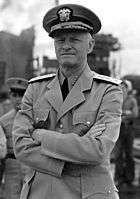
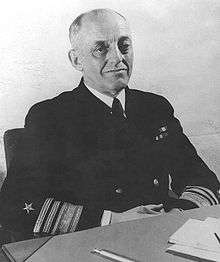

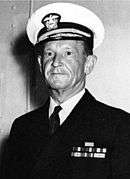

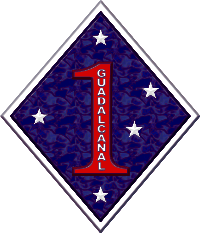
The roles of Commander in Chief, Pacific Ocean Areas (CINCPOA) and Commander in Chief, U.S. Pacific Fleet (CINCPAC), were both exercised by Admiral Chester W. Nimitz from his headquarters at Pearl Harbor, Hawaii.
Since the Solomons lie in the Southern Pacific, the landings of 7 August 1942 on Guadalcanal were the responsibility of the South Pacific Fleet, led by Vice Admiral Robert L. Ghormley from his headquarters at Noumea, New Caledonia.[1] Adm. Ghormley's pessimism, inadequate staff work and unwillingness to visit the front led Adm. Nimitz to replace him with the much more aggressive and hands-on Vice Admiral William F. Halsey on 18 October 1942.[2]
Operational command of the invasion was assigned to Vice Admiral Frank Jack Fletcher. He also had direct command of the covering force, designated Task Force 61, where he flew his flag aboard fleet carrier Saratoga. The amphibious forces, Task Force 62, were led by Rear Admiral Richmond Kelly Turner aboard attack transport McCawley.
Bitter disputes between the two men arose during both the planning and execution of the invasion over how long Fletcher's aircraft carriers would stay in the vicinity of Guadalcanal to provide air cover for the Marines ashore. Fletcher decided the matter after multiple assaults on the Allied amphibious force by bombers from the Japanese base at Rabaul on D-Day and D+1. These attacks convinced Fletcher that his crucial aircraft carriers could not be risked in the waters of the Solomons any longer and he ordered his carriers out of the area on the night of 8 August. Unsettled by the removal of air cover and rattled the following morning by the discovery that his cruiser screen had been decimated at the Battle of Savo Island, Turner ordered his vulnerable, and still half-full, cargo ships back to Noumea around sundown 9 August. The Marine Corps forces ashore were thus left without air cover or the planned level of food and ammunition.
The 1st Marine Division's struggle to take Guadalcanal from the Imperial Japanese Army achieved legendary status; the unit's insignia features a large red numeral 1 with the word "Guadalcanal" superimposed. Three future commandants of the Marine Corps fought on "The Canal": Alexander A. Vandegrift, Clifton B. Cates and Lemuel C. Shepherd.
The initial US landings on Guadalcanal and Tulagi on 7 August 1942 were made by the 1st Marine Division under the command of Maj. Gen. Alexander A. Vandegrift. On 8 December he was replaced by Army Maj. Gen. Major General Alexander M. Patch, who then was named commander of the XIV Army Corps on 2 January 1943.
Marine Corps
1st Marine Division

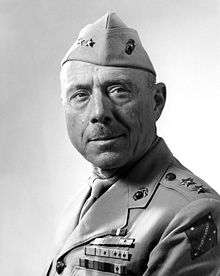
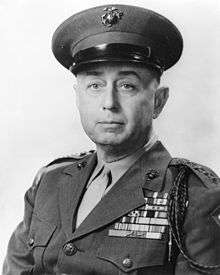
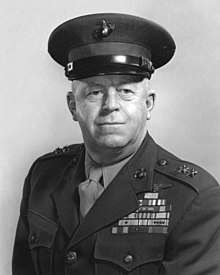
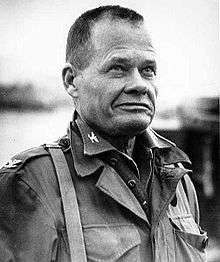

Maj. Gen. Alexander A. Vandegrift
The D-Day (7 August) landings on Guadalcanal were carried out by the 1st and 3rd Battalions/5th Marines at 0910 hours, followed by the 1st Marines at 0930. Landings on the Florida Islands across the sound were carried out earlier that morning by the 2nd Battalion/5th Marines, the 1st Parachute Battalion, and the 1st Marine Raider Battalion.[3] The 7th Marines and 1st Battalion/11th Marines arrived 18 September. The division began withdrawal from the island 12 December.
- Division staff
- Asst. division commander: Brig. Gen. William H. Rupertus[lower-alpha 1]
- Chief of staff: Col. William C. James[lower-alpha 2] (to 24 Sept); Col. Gerald C. Thomas
- Asst. chief of staff for Personnel (D-1): Col. Robert C. Kilmartin Jr.
- Asst. chief of staff for Intelligence (D-2): Lt. Col. Frank B. Goettge[lower-alpha 3] (to 12 Aug); Lt. Col. Edmund J. Buckley
- Asst. chief of staff for Operations (D-3): Col. Gerald C. Thomas (to 24 Sept); Lt. Col. Merrill B. Twining
- Asst. chief of staff for Logistics (D-4): Lt. Col. Randolph M. Pate
- 1st Marine Regiment
- Commanding officer: Col. Clifton B. Cates[lower-alpha 4]
- Executive officer: Lt. Col. Julian N. Frisbie (to 23 Sept); Lt. Col. Edwin A. Pollock
- 1st Battalion: Lt. Col. Leonard B. Cresswell
- 2nd Battalion: Lt. Col. Edwin A. Pollock (to 23 Sept); Lt. Col. William W. Stickney
- 3rd Battalion: Lt. Col. William N. McKelvy Jr.
- 5th Marine Regiment
- Commanding officer: Col. Leroy P. Hunt[lower-alpha 5] (to 21 Sept); Col. Merritt A. Edson
- Executive officer: Col. William J. Whaling (to 25 Sept); Lt. Col. Walker A. Reaves (to 12 Oct); Lt. Col. William S. Fellers
- 1st Battalion: Lt. Col. William E. Maxwell (to 30 Aug)[lower-alpha 6]; Maj. Donald W. Fuller (to 13 Oct); Maj. William K. Enright
- 2nd Battalion: Lt. Col. Harold E. Rosecrans (to 11 Sept); Capt. Joseph J. Dudkowski (1-17, 25-30 Sept); Lt. Col. Walker A. Reaves (18-24 Sept); Maj. David S. McDougal (1-8 Oct); Maj. William J. Piper (8-11 Oct); Maj. Lewis W. Walt
- 3rd Battalion: Lt. Col. Frederick C. Biebush (to 22 Sept); Maj. Robert O. Bowen
- 7th Marine Regiment
- Commanding officer: Col. James W. Webb[lower-alpha 7] (to 20 Sept); Col. Amor L. Sims
- Executive officer: Col. Amor L. Sims (to 20 Sept); Lt. Col. Julian N. Frisbie
- 1st Battalion: Lt. Col. Lewis B. "Chesty" Puller[lower-alpha 8]
- 2nd Battalion: Lt. Col. Herman H. Hanneken[lower-alpha 9]
- 3rd Battalion: Lt. Col. Edwin J. Farrell (to 24 Sept); Lt. Col. William R. Williams
- 11th Marine Regiment (Artillery)
- Commanding officer: Col. Pedro del Valle[lower-alpha 10]
- Executive officer: Lt. Col. John A. Bemis (to 17 Oct); Lt. Col. Robert B. Luckey (to 28 Nov); Lt. Col. Thomas B. Hughes
- 1st Battalion: Lt. Col. Joseph R. Knowlan (to 19 Oct); Lt. Col. Manley L. Curry (to 28 Nov); Lt. Col. Donovan D. Sult (to 2 Dec)
- 2nd Battalion: Lt. Col. Edward G. Hagen (to 14 Sept); Maj. Forest C. Thompson
- 3rd Battalion: Lt. Col. James J. Keating
- 4th Battalion: Lt. Col. Melvin E. Fuller (to 28 Oct; from 7 Dec); Maj. Carl G.F. Korn (28-31 Oct); Capt. Albert H. Potter (from 1 Nov)
- 5th Battalion: Lt. Col. E. Hayden Price (to 18 Oct); Maj. Noah P. Wood, Jr.
- Other Marine units
- 3rd Defense Battalion (landed 7 August 1942): Col. Robert H. Pepper
- Executive officer: Lt. Col. Harold C. Roberts
- Operations officer: Maj. Samuel G. Taxis
- 1st Parachute Battalion: Maj. Charles A. Miller (to 18 Sept); Capt. Harry Torgerson (19-26 Sept); Maj. Robert H. Williams (from 27 Sept)
- 1st Raider Battalion: Col. Merritt A. Edson (to 21 Sept); Lt. Col. Samuel B. Griffith (22-27 Sept)
- 1st Amphibian Tractor Battalion Lt. Col. Walter W. Barr:
- 1st Aviation Engineer Battalion Maj. Thomas F. Riley:
- 1st Pioneer Battalion: Maj. James G. Frazer (to 25 Oct); Maj. Henry H. Crockett
- 1st Medical Battalion: Cmdr. Don S. Knowlton, USN
- 1st Special Weapons Battalion: Maj. Robert B. Luckey (to 6 Oct); Maj. Richard W. Wallace
- 1st Tank Battalion: Maj. Harvey S. Walseth
- 3rd Defense Battalion (landed 7 August 1942): Col. Robert H. Pepper
2nd Marine Division


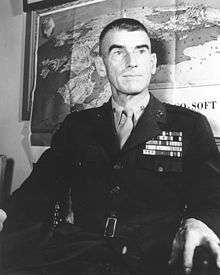
Brigadier General Alphonse DeCarre
The 2nd Marines reinforced by the 3rd Battalion/10th Marines were part of the initial 7 August landings. The reinforced 8th Marines landed on 2 November and the reinforced 6th Marines on 4 January 1943.
- Division staff
- Asst. to commanding general: Col. Leo D. Hermle[lower-alpha 11]
- Chief of staff: Col. George F. Stockes
- Asst. chief of staff for Personnel (D-1): Maj. Lawrence C. Hays Jr.
- Asst. chief of staff for Intelligence (D-2): Maj. Thomas J. Colley
- Asst. chief of staff for Operations (D-3): Lt. Col. John H. Coffman
- Asst. chief of staff for Logistics (D-4): Maj. George N. Carroll
- Division special troops: Col. Maurice G. Holmes
- 2nd Marine Regiment
- Commanding officer: Col. John M. Arthur
- Executive officer: Lt. Col. William S. Fellers (to 9 Oct); Lt. Col. Cornelius P. Van Ness
- 1st Battalion: Lt. Col. Robert E. Hill (to 10 Nov); Maj. Wood B. Kyle
- 2nd Battalion: Maj. Orin K. Pressley
- 3rd Battalion: Maj. Robert G. Hunt
- 6th Marine Regiment
- Commanding officer: Col. Gilder D. Jackson Jr.
- Executive officer: Lt. Col. Alfred A. Watters (to 15 Dec); Lt. Col. Lyman G. Miller
- 1st Battalion: Lt. Col. Russell Lloyd
- 2nd Battalion: Maj. Raymond L. Murray
- 3rd Battalion: Maj. William A. Kengla
- 8th Marine Regiment
- Commanding officer: Col. Richard H. Jeschke
- Executive officer: Lt. Col. James P. Riseley
- 1st Battalion: Lt. Col. Miles J. Newton (to 22 Nov); Maj. Joseph B. McCaffery
- 2nd Battalion: Lt. Col. John H. Cook Jr.
- 3rd Battalion: Lt. Col. Augustus H. Fricke
- 10th Marine Regiment (Artillery)
- Commanding officer: Col. Thomas E. Bourke
- Executive officer: Lt. Col. Ralph E. Forsyth
- 1st Battalion: Lt. Col. Presley M. Rixey
- 2nd Battalion: Maj. George R. E. Shell
- 3rd Battalion: Lt. Col. Manly L. Curry (to 18 Oct; from 28 Nov); Lt. Col. Donovan D. Sult (18 Oct-28 Nov)
- 4th Battalion: Lt. Col. Kenneth A. Jorgensen
- Other Marine units
- 2nd Amphibian Tractor Battalion: Maj. Henry C. Drewes
- 9th Defense Battalion (landed December 1942)
- Commanding officer: Col. David R. Nimmer
- Executive officer: Lt. Col. William J. Scheyer
- Operations officer: Capt. William C. Givens
- 2nd Raider Battalion: Lt. Col. Evans F. Carlson
- 2nd Special Weapons Battalion: Lt. Col. Paul D. Sherman
- 2nd Tank Battalion: Maj. Alexander B. Swenceski
- 6th Naval Construction Battalion: Lieutenant Commander Joseph L. Blundon, CEC[4] (Started landing on 27 August)
- 3rd Battalion 18th Marines (started landing on 12 December)[5]
Army
Americal Division
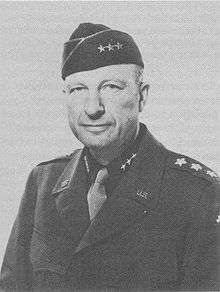
Major General Alexander M. Patch[lower-alpha 12]
Arrived in echelons beginning 13 October
- 132nd Infantry Regiment (Illinois National Guard)
- 164th Infantry Regiment (North Dakota National Guard)
Landed 13 October
- 182nd Infantry Regiment (Massachusetts National Guard)
Landed 12 November
- 147th Infantry Regiment (Separate) (Ohio National Guard)
- 97th Field Artillery Battalion
- 214th Coast Artillery (United States)
- 244th Coast Artillery Regiment
- 221st Field Artillery Battalion
- 245th Field Artillery Battalion
- 246th Field Artillery Battalion
- 247th Field Artillery Battalion
- 57th Engineer Combat Battalion
25th Infantry Division
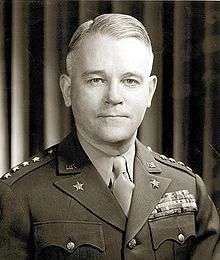
Major General J. Lawton Collins[lower-alpha 13]
Arrived in echelons beginning 17 December
- 27th Infantry Regiment
- 35th Infantry Regiment
- 161st Infantry Regiment (Washington National Guard)
- Battalion-level units
- 8th Field Artillery Battalion
- 64th Field Artillery Battalion
- 89th Field Artillery Battalion
- 90th Field Artillery Battalion
- 65th Engineer Combat Battalion
Service Command, South Pacific Theater of Operations
Brigadier General Raymond E. S. Williamson
- 70th Coast Artillery
- Engineer units
- Supply units
- Military Police units
Japanese
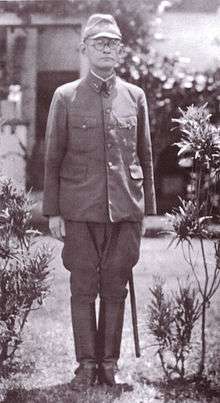
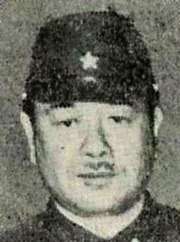
On 10 August 1942, the Imperial Japanese Army's Seventeenth Army[lower-alpha 14] under Lieutenant General Harukichi Hyakutake assumed command of the Japanese efforts to retake Guadalcanal. The General arrived on the island to take direct command on 10 October.[6]
2nd Infantry (Sendai) Division
Lieutenant General Masao Maruyama
Landed between 5 September and 4 October
- 4th Infantry Regiment
- 16th Infantry Regiment
- 29th Infantry Regiment
- 2nd Artillery Regiment
- 2nd Engineer Battalion
38th Infantry Division
Lieutenant General Tadayoshi Sano
The depleted 38th Division landed 5–15 November
- 228th Infantry Regiment
- 229th Infantry Regiment
- 230th Infantry Regiment
- 38th Mountain Gun Regiment
- 38th Engineer Battalion
35th Brigade
Major General Kiyotaki Kawaguchi[lower-alpha 15]
Landed 29 August–5 September; included a late-arriving battalion of the 28th Infantry Regiment. The Ichiki detachment arrived 18–24 August.
- 124th Infantry Regiment
- Kitao Battalion/Ichiki Detachment
- 4th Artillery Regiment
- 10th Mountain Gun Battalion
- 20th Mountain Gun Battalion
Other units
- 28th Infantry Regiment
Arrived on Guadalcanal 6 July to begin construction of an airstrip:
- 11th Construction Unit
- 13th Construction Unit
Notes
- Later rose to division command
- Relieved by Vandegrift for poor performance
- Killed when a patrol he had organized encountered unexpected Japanese resistance and was essentially wiped out
- Later rose to Corps command and post-war Commandant of the Marine Corps
- Relieved by Vandegrift for poor performance
- Relieved for perceived lack of aggressiveness
- Relieved by Vandegrift for poor performance
- Eventually became most-decorated man in history of Marine Corps
- Commanded 7th Marines during Battle of Peleliu
- Commanded 1st Marine Division during Okinawa Campaign
- Later rose to regimental and assistant division command
- Later rose to army command during the liberation of Europe
- Later rose to Corps command during the liberation of Europe and Army Chief of Staff during Korean War
- A Japanese army was equivalent to a Euro-American corps.
- Relieved 23 October and given rear-area command after repeated refusal to obey orders
References
Bibliography
- Morison, Samuel Eliot (1949). Coral Sea, Midway and Submarine Actions, May 1942 – August 1942. History of United States Naval Operations in World War II. IV. Boston: Little, Brown and Co.
- Morison, Samuel Eliot (1948). The Struggle for Guadalcanal, August 1942 – February 1943. History of United States Naval Operations in World War II. V. Boston: Little, Brown and Co.
- Stille, Mark (2015). Guadalcanal, 1942–43: America's first victory on the road to Tokyo. Oxford: Osprey.